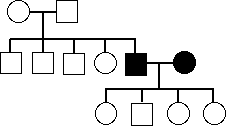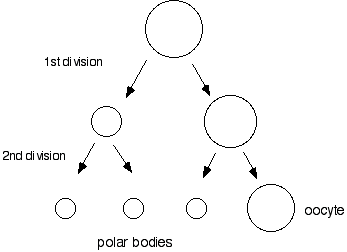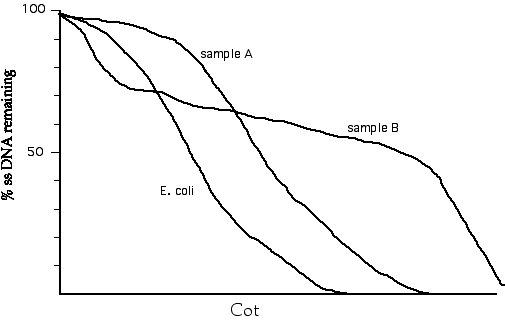
1) 18 pts
. Answer True or False. If the statement is TRUE, explain or give a supporting example. If the statement is FALSE, either explain the problem with the statement or give a counter example.a) This pedigree is consistent with autosomal dominant inheritance.

True. The parents could be heterozygous.
b) This pedigree is consistent with X-linked recessive inheritance.

True. The mother could have been heterozygous.
c) Mendel’s principle of segregation states that genes on different chromosomes may separate during the production of gametes.
False. This is a statement of the 2nd Law. Independent assortment. The first law states that alleles segregate from each other.
d) A test cross is a mating between an individual of unknown genotype with a homozygous dominant individual.
False. A testcross is unknown X homozygous recessive.
e) Grasshoppers have an X0 sex determination mechanism. This means that males are the heterogametic sex.
True. Heterogametic means to produce two kinds of gametes. In grasshoppers males produce X bearing and nullo-X sperm. Females produce X bearing eggs.
f) The LOD score method can be used to test for recombination.
False. LOD score are a measure of linkage. They do not test recombination as recombination is one of the things that is observed in LOD score analysis.
2) 22 pts. Short Answer section: Answer the following questions and provide a short explanation.
a) Is it possible for a single allele to be both dominant and recessive? If yes, explain or give a supporting example, if no, explain why not.
Yes. One example is the white gene. The wapricot allele is dominant to w-, but is recessive to w+.
b) A couple, neither of whom has phenylketonuria (an autosomal recessive trait), have a child with PKU as their first child. They plan to have three more children. What is the likelihood that at least one of these additional kids will have PKU?
Since the parents were unaffected and produced an affected child they are heterozygous. This means the chance than any one child will have PKU is 1/4. The odds that at least one kid will be affected equals 1- Prob that none of the three will be affected = 1 — (3/4 X 3/4 X 3/4) = 1- 27/64 = 37/64 = 57.8%
c) About one person in 70 is heterozygous for albinism. A normal woman whose parents were normal but who has an albino brother marries an unrelated normal man. What is the probability that if they have a child it will be an albino? Would the probability be larger if the woman marries her cousin?
Since the woman had an albino brother, her parents must have been heterozygous. This means there is a 2/3 chance she is heterozygous and a 1/3 chance homozygous and unaffected.
The probability that the woman’s husband is heterozygous is 1/70. Therefore the probability of an albino child is 2/3 X 1/70 X 1/4 = 1/420 or 0.238 %.
If she married her cousin the probability would be higher since her cousin would have a greater than average chance of being heterozygous.
d) Offer an explanation for the following pedigree if: i) one gene is involved, or ii) more than one gene is involved.

i) If one gene, it is likely dominant inheritance with incomplete penetrance. If it were recessive inheritance you would expect the children to be affected. If it were a simple dominant one of the first generation should have been affected.
ii) If two genes are involved, this could be an example of complementation. Human deafness for example can be caused by genes that affect the structure of the cochlea and those that effect the formation of the auditory nerve. In this case you would have one a/a homozygote crossed with a b/b heterozygote and the progeny would all be a/+; b/+.
e) Many RNA viruses contain either double-stranded RNA genomes or produce ds RNA molecules during replication. One cellular enzyme that may be involved in antiviral defense is adenosine deaminase. Adenosine deaminase modifies adenine bases in dsRNA converting them into inosine which has the pairing properties of guanine. Briefly speculate on why this enzyme activity could provide protection against RNA viruses.
This could work by several mechanisms. Modification of the dsRNA would disrupt base pairing as the I residues would not be complementary to the U residues across the helix. This should lead to denaturation of the ds RNA.
The change from A to I should also cause mutations in the viral genome if the genomic RNA is affected or alter the protein products of the viral mRNAs if the mRNA template is affected.
A change from A to I would lead to the AU pairs in the viral RNA being converted to GC pairs as shown:
A:U Ô I — U. Upon replication this leads to an I:C and A:U strands. If translated I will be read as G rather than the correct A causing mistakes in translation.
3) 18 pts. Recall the meiotic process that generates an egg.

Turkey eggs sometimes develop without fertilization (parthenogenesis). There are three plausible mechanisms: (a) the egg could simply fail to enter meiosis, remaining diploid; (b) the egg nucleus could be fertilized by a polar body; (c) the chromosomes of a haploid nucleus could double.
Predict the sex ratio in the progeny for each of the three hypotheses. (Remember, in birds the female is the heterogametic sex, where the Z chromosome is analogous to the mammalian X, and the W analogous to the Y.)
(a) Female. All animals genotype ZW which is a female karyotype.
(b) 4/5 female, 1/5 male. Eggs start out as either Z (50%) or W (50%). If egg is Z, polar bodies are 2/3 W and 1/3 Z. If egg is W, polar bodies are 2/3 Z and 1/3 W. P (ZZ) (male) = 1/2 (1/3) = 1/6. p (ZW) (female) = [1/2 (2/3) + 1/2 (2/3)] = 4/6. WW embryos (1/6) are dead. So ratio of female to male is 4:1.
(c) All turkeys are males. Z eggs develop into ZZ diploids and W eggs die since WW genotype is analogous to YY genotype.
4) 12 pts. In a cat species, eye color can be gray, blue, green, or brown, and each trait is true breeding. In separate crosses involving homozygous parents the following data were obtained:
|
Cross |
P1 |
F1 |
F2 |
|
A |
green X gray |
all green |
3/4 green:1/4 gray |
|
B |
green X brown |
all green |
3/4 green:1/4 brown |
|
C |
gray X brown |
all green |
9/16 green; 3/16 brown; 3/ 16 gray; 1/16 blue |
a) How many genes are involved? Define gene symbols and indicate which genotypes yield each phenotype.
A–Parentals: GG X gg F1: Gg X Gg F2 3/4 Green G_ and 1/4 gray gg.
B–Parentals: BB X bb F1: Bb X Bb F2 3/4 Green B_ and 1/4 brown bb.
C–Parentals: gg BB X GG bb F1: Gg Bb X GgBb F2 9/16 Green G_ B_ ;
3/16 brown G_bb; 3/16 gray BB gg; and 1/16 blue ggbb.
b) In a cross between a gray eyed cat and one of unknown genotype and phenotype the F1 generation was not observed. However, the F2 resulted in the same F2 ratio as cross C. Determine the genotypes and phenotypes of the unknown P1 and F1 cats.
To get gray P#1 it must have been either gg BB or gg Bb.
To get the same F2 ratio the cross must have been between two doubly heterozygous cats.
Gg Bb. If P#1 was ggBB P#2 must have been GGbb (brown). This would make the F1 generation AaBb (green). If P#1 was ggBb no combination of GG __ would give a uniform F1 genotype which would be needed to generate the F2 ratio.
5) 12 pts. Consider the following DNA replication intermediate in E. coli.

a) Label the strands 5’ and 3’.
5’--------------------------------3’
3’--------------------------------5’
b) With regards to the enzymes and activities listed below, which ones have completed their roles in DNA replication? Which have not? Briefly explain your answers.
DNA polymerase I The RNA primer is still in place. Therefore:
5’-3’ exonuclease is not finished it removes the primer
3’-5’ exonuclease is not finished as it must proofread any new synthesis
5’-3 polymerase is not finished as it must replace the RNA primer with DNA.
DNA polymerase III All primary synthesis has been completed. All this is needed is to remove the primer and replace it with DNA, and then ligate the strands.
3’-5’ exonuclease -finished Pol III activity is complete no further need for proofreading.
5’-3’ polymerase -finished Pol III activity is complete
DNA ligase incomplete. The final 3’-0H, 5’-P gap must be ligated.
DNA primase–finished the RNA primer has been laid down.
DNA helicase–finished Pol I removes the primer while filling in the new synthesis there is not need to separate the strands.
Single stranded binding protein (SSB)– finished There is no need to separate the strands and thus there will be no single-stranded regions.
6) 18 pts. The mutation SxlM1 is a male-specific X-linked lethal allele that kills males without effecting females. The Sxl gene maps immediately adjacent to carmine eyes (cm) at 20.0 cM. Recently a female-specific recessive lethal that also maps on the X (flex1 —female lethal on X) was reported to partially suppress the male-lethal phenotype of SxlM1. That is, males of genotype SxlM1 flex1/ Y sometimes survive, whereas SxlM1/ Y males always die. On its own, flex1 has no phenotype in males. The flex gene maps at 54.0 cM. To assess the ability of flex1 to rescue SxlM1 males the following cross was done:
cm SxlM1 + / + + flex1
™™ X ¢¢ +++ /YThe following progeny were recovered:
Females 2028
Males 987 cm+
95 cm
a) Using the information provided, estimate the efficiency with which the flex1 mutation rescues the SxlM1 male-lethal effect. Show your work.
In the absence of lethal effects we should have recovered 987 cm- SxlM1 males. Of these 987 males some 336 should have been recombinants carrying flex.
987 Sxl-M1 X (54 — 20 cM --distance between Sxl and flex--) = 987 X 0.34 = 336.
If flex fully rescued Sxl-M1 all 336 Sxl-M1 flex double mutant males should have been viable. Instead only 95 survived. This means that 28% (95/336) of the expected double mutants survived or that rescue was 28%.
If you used 1/2 the total number of females as viability standard this was acceptable:
1014 X .34 = 345 expected = 95 observed /345 expected = 27.5%.
b) What was the purpose of cm in this experiment?
Since Sxl-M1 has no visible phenotype, cm served as a maker or indicator of Sxl genotype. To see the importance of this. Consider if cm had not been present. You would then have recovered 2028 females and 1082 males. Given these numbers you could not have known if any Sxl-M1 males survived as 2 X (1082) = 2164 is not very different from 2028.
c) The flex allele is a suppressor of the SxlM1 mutation. Does flex exhibit variable penetrance or variable expressivity with respect to its ability to rescue SxlM1? Explain.
This is an example of variable penetrance. Flex either rescues the males or it does not. Penetrance is refers to the expression of the phenotype or its absence. It has a yes or no answer. Expressivity refers to the degree with which a phenotype is expressed. Death does not allow of degree.
Extra credit 4 pts
EC) Compare the following Cot curves representing DNA rehybridization kinetics. What can be said about the two unknown DNAs with respect to E. coli DNA?

Sample A has a similar structure to E. coli–that is it’s composed primarily of single copy sequences. The genome is larger than that of E. coli since the reassociation of the single strands is slower.
Sample B is likely a eukaryotic sample. It contains different kinds of DNA. In this case 20 —25% of the genome appears to be highly repetitive DNA and renatures quickly. The single copy sequences of sample B renature more slowly than those of E. coli indicating that the single genome size or organism B is larger than E. coli or of sample B.